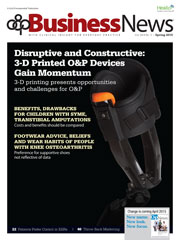Editor’s note: The following Guest Commentary is a response to the story “Disruptive and Constructive: 3-D Printed O&P Devices Gain Momentum” in the Spring 2015 issue of O&P Business News.
The phenomenon of 3-D printing is certainly a technology that will change the approach to creating new physical objects, including medical devices. As an engineer, I endorse the development of new technologies wholeheartedly. However, I would ask for caution not to fall into the trap of the idea that “everything is possible now.”

Wieland Kaphingst
Additional considerations apply to 3-D printing as a technology opening the door of design and creation “for everyone.” The undisputed fact that a student or someone with a lack of technical knowledge can print a complex piece or – in our case – something that looks somewhat like a prosthetic hand does not mean that this device can technically and in the long term compete with the function of time- and machine-tested products. These devices are not required to follow and fulfill all regulatory requirements of the medical device regulations; to meet the International Standardization Organization (ISO) standards; to meet minimum clinical outcome requirements that those in the field of patient care have agreed upon; and are designed by non-professionals in a non-understanding trial and error approach.
3-D printing not disruptive
Disruptive innovation helps create a new market and value network and eventually disrupts an existing market and value network and displaces earlier technology. A technology or a product is proven disruptive only after it has shown to be able to disrupt an existing market.
Technology is not disruptive just because it can be designed and manufactured. It looks completely different than the original looked. It is cheap and can be done immediately. 3-D printed prostheses and orthoses may become disruptive in the future, but are not yet. Those with a knowledge of the field do not consider a three-strut-supported transfemoral socket design with a proximal weight bearing ring that has partially been made with the aid of 3-D printing disruptive. The struts are long carbon fiber laminates, a technology of recent years and necessary to support the weight of the patient.

The concept of the strut-supported ring socket has been around since the 1950s. It never took off (except as a nightly quick-don “go-to-the bathroom leg”) because it did not provide the minimal function of a 1950s wooden leg with a wooden “plug fit” socket.
3-D hype burdens O&P providers
The issue of disruptive technology is important in relation to reimbursement. Our profession fights for survival and the patient needs to fight for their right. The O&P profession is unfairly considered as fraudulent by many politicians. Necessary quality custom devices are questioned by the reimbursement system and not provided in prescriptions any more. Politicians who have no clinical or technical knowledge shout at every opportunity that health care is too expensive. This leads them to beat down on O&P which is one of the smallest and weakest players in the health care market.
The hype of O&P providing unaffordable arm prostheses when you can make them yourself with a 3-D printer for little money supports the assumption that O&P is fraudulent. A 3-D printer is not a gift from heaven, however, neither is a qualified technician.
For more information:
Wieland Kaphingst, Dipl.-Ing., CPO, FAAOP, is a biomedical engineer and global director of BD, Clinical Education and Research for Tamarack Habilitation Technologies Inc.
Disclosure: Kaphingst reports no relevant financial disclosures.


